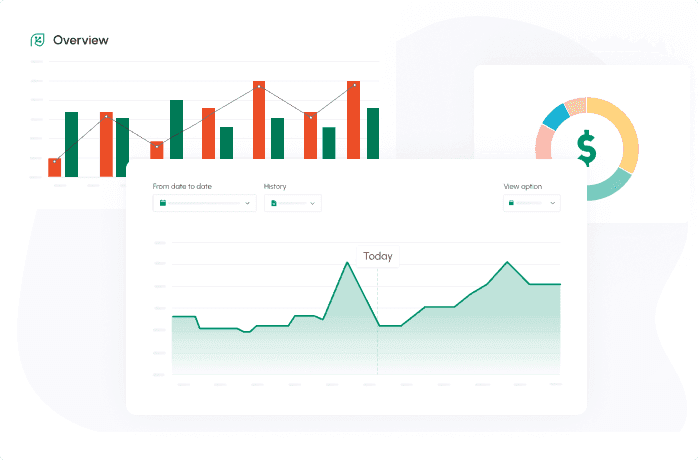Types of Cash Flow - Operating, Investing, Financing, Free

The type of cash flows your business has will include:
- Cash flows from operations
- Cash flow from investment
- Cash flow from financing
If your business isn’t monitoring each type of cash flows, it may not be getting the complete picture of the business's financial standing. Let's look at each type of cash flow so that you can have a good understanding of each.
What is Cash Flow?
Before we discuss the type of cash flows you may have, it’s important to know what cash flow even means. In the accounting world, this is a term to designate:
- All cash going into the business, known as inflows
- All cash going out of the business, known as outflows
Total cash flow can be positive or negative, and it’s calculated by subtracting your outflows from inflows.
Cash flow has to include the actual money that comes into the business and can be used. For example, you can send out an invoice today, but until it’s paid, you can only count the costs involved in the invoice in your cash flow.
If you make a product, sell it to a customer and wait for the invoice to be paid, you cannot count the cash flow from the sale.
Instead, the cash can only be added to your inflows when the money hits your business bank account. Cash inflows and outflows occur in business daily, and you need to calculate cash flow based on these inflows and outflows.
Every activity performed where money is exchanged can be broken down into three different types of cash flow.

Types of Cash Flow
Now that you understand what cash flow is, it’s crucial to look at each type of cash flow to break your branded reports down even further. Oftentimes, most of your inflows will come from operations, but if you sell real estate or a subsidiary of your business, one of the other cash flow types may be the main source of inflows for the business.
Cash Flow from Operations (CFO)
Cash flows from operations are what most businesses think of when they think of their main type of cash flows. This is the money that comes into the business from cash activities, such as from selling products or services.
However, cash expenditures are also included in the mix.
Example Of Cash Flow from Operating Activities
Operating activities can have many inflows and outflows. However, let’s make the type of cash flows as simple to understand as possible:
- Cash inflows may include things such as the cash paid for products and services to the business.
- Cash outflows may include any expense that you had to maintain operating activities, such as paying for supplies or merchandise of some type.
As with each type of cash flows, you’ll need to calculate your total inflows and outflows. The next step is to subtract your outflows from inflows to determine the true cash flow from operating activities.
Cash Flow from Investing (CFI)
Cash flows from investment is the next type of cash flows, and it’s often abbreviated to just CFI. Businesses often have money going into and out of the business for various investments.
Example Of Cash Flow from Investing Activities
Investments are one of the inflows and outflows that are most difficult to understand because they can include multiple things. When you have CFI, this may include the following:
- Cash inflows would include things such as money earned from selling a piece of real estate that the business owns. You can also have inflows from interest paid on loans that you lent to others.
- Cash outflows may include expenses made for the investment. For example, you may have outflows if you invest money in a new plant or equipment to streamline operations more.
Investments are going to include noncurrent assets, and this may include multiple things, such as long-term investments, real estate, property and equipment investments.
Cash Flow from Financing (CFF)
Cash flows from financing activities, often abbreviated to CFF, are any cash activities for owners’ equity or noncurrent liabilities. This is a very important method of cash flow, although it can be difficult to fully understand without an example.
Example Of Cash Flow from Financing Activities
Financing activities are a part of business, and they may include some of the following:
- Cash inflows may include things such as the sum of a loan or the sale of stock to generate capital for the business.
- Cash outflows may include activities, such as stock repurchases or making dividend payments to investors.
Your financing activities are often difficult to break down into cash flow, but it’s important to know that they’re all noncurrent liabilities and anything related to owners’ equity.
Now that we understand all three types of cash flow, it’s crucial to understand that a cash flow statement may include all types or not. The accountant or software you use may just consider all inflows and outflows, depending on the cash flow method chosen.
Either method works fine for businesses, but most will benefit from the fine details provided when all three cash flow segments are listed.
Free Cash Flow
Free flow cash, also known as FCF, is the amount of cash that your business has to pay for:
- Dividends
- Interest
- Creditors
Higher FCF means that the business has money to repay its debts and take advantage of growth opportunities. You'll find the FCF of a business by subtracting the total of your capital expenditures from your operating cash flow.
Businesses with high FCF will want to leverage the cash that they have at their disposal to begin paying down debts and even expand the business.
FCF means your business has the financial freedom it needs to keep growing. However, if this figure is too low, it means that you need to increase each type of cash flows listed above to bring more money into the business.
If you cannot generate more revenue, it may be wise to begin reducing your expenditures.

The Importance of Cash Flow Analysis for Every Business
Understanding each type of cash flows is only possible with analysis. Business owners and stakeholders should analyze reports and statements because they’ll help you understand:
- Your business's financial standing
- Potential, future financial issues
- When you can invest
- When to seek financing
- If the business has healthy finances
f you assume that your business is doing well and has strong financials, you put your business at risk. The only way to know the true financial strength of a business is to go through each type of cash flows and ensure more money is coming into the business than is going out.
When cash flow falls into the negative, you’ll need to either reduce expenses or seek out financing.
Easily Analyze Cash Flow with Cash Flow Frog Software
Now that you know the types of cash flows, it’s important to be able to easily analyze the three types of cash flows. One of the best options is to use software to look through your cash flow and make your data easy to read.
Cash Flow Frog offers charts, graphs and reports to help you understand:
- Free flow cash
- Cash flows from operating activities, investment and financing
- Inflows and outflows
Proper analysis of your data will make it easier for you to make adjustments to keep your business financially stable.

Current Liabilities: Meaning, Examples, and How to Calculate Them
Read more

What Is a Finance Charge? A Simple Explanation You’ll Actually Use
Read more

Current Assets Explained: Meaning, Types, and How They Work
Read more

Cash Flow Forecasting Template
Read more

Your Guide To Financial Metrics And KPIs
Read more

10 Cash Management Trends for 2026
Read more
FAQ
Trusted by thousands of business owners
Start Free Trial Now